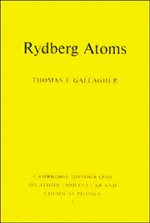Book contents
- Frontmatter
- Contents
- Preface
- 1 Introduction
- 2 Rydberg atom wavefunctions
- 3 Production of Rydberg atoms
- 4 Oscillator strengths and lifetimes
- 5 Black body radiation
- 6 Electric fields
- 7 Pulsed field ionization
- 8 Photoexcitation in electric fields
- 9 Magnetic fields
- 10 Microwave excitation and ionization
- 11 Collisions with neutral atoms and molecules
- 12 Spectral line shifts and broadenings
- 13 Charged particle collisions
- 14 Resonant Rydberg–Rydberg collisions
- 15 Radiative collisions
- 16 Spectroscopy of alkali Rydberg states
- 17 Rf spectroscopy of alkaline earth atoms
- 18 Bound He Rydberg states
- 19 Autoionizing Rydberg states
- 20 Quantum defect theory
- 21 Optical spectra of autoionizing Rydberg states
- 22 Interseries interaction in bound states
- 23 Double Rydberg states
- Index
8 - Photoexcitation in electric fields
Published online by Cambridge University Press: 29 September 2009
- Frontmatter
- Contents
- Preface
- 1 Introduction
- 2 Rydberg atom wavefunctions
- 3 Production of Rydberg atoms
- 4 Oscillator strengths and lifetimes
- 5 Black body radiation
- 6 Electric fields
- 7 Pulsed field ionization
- 8 Photoexcitation in electric fields
- 9 Magnetic fields
- 10 Microwave excitation and ionization
- 11 Collisions with neutral atoms and molecules
- 12 Spectral line shifts and broadenings
- 13 Charged particle collisions
- 14 Resonant Rydberg–Rydberg collisions
- 15 Radiative collisions
- 16 Spectroscopy of alkali Rydberg states
- 17 Rf spectroscopy of alkaline earth atoms
- 18 Bound He Rydberg states
- 19 Autoionizing Rydberg states
- 20 Quantum defect theory
- 21 Optical spectra of autoionizing Rydberg states
- 22 Interseries interaction in bound states
- 23 Double Rydberg states
- Index
Summary
Hydrogenic spectra
A good starting point is photoexcitation from the ground state of H. The problem naturally divides itself into two regimes: below the energy of classical ionization limit, where the states are for all practical purposes stable against ionization, and above it where the spectrum is continuous.
As an example, we consider first the excitation of the n = 15 Stark states from the ground state in a field too low to cause significant ionization of n = 15 states. From Chapter 6 we know the energies of the Stark states, and we now wish to calculate the relative intensities of the transitions to these levels. One approach is to calculate them in parabolic coordinates. This approach is an efficient way to proceed for the excitation of H; however, it is not easily generalized to other atoms. Another, which we adopt here, is to express the n = 15 nn1n2m Stark states in terms of their nℓm components using Eqs. (6.18) or (6.19) and express the transition dipole moments in terms of the more familiar spherical nℓm states.
In the excitation of the Stark states of principal quantum number n from the ground state only p state components are accessible via dipole transitions, so the relative intensities for light polarized parallel and perpendicular to the static field, π and σ polarizations, are proportional to the squared transformation coefficients |〈nn1n2m|nℓm〉|2 from the nn1n2m parabolic states to the nℓm states for ℓ = 1 and m = 0 and 1. In Fig. 8.1 we show the relative intensities by means of the squared transformation coefficients |〈15n1n2m|15pm〉|2 for m = 0 and 1.
- Type
- Chapter
- Information
- Rydberg Atoms , pp. 120 - 142Publisher: Cambridge University PressPrint publication year: 1994

